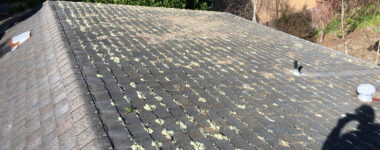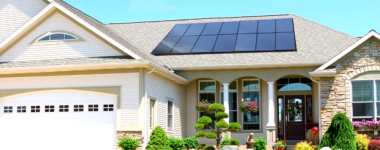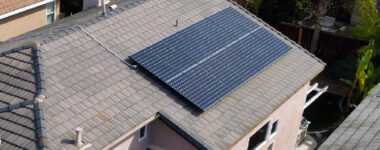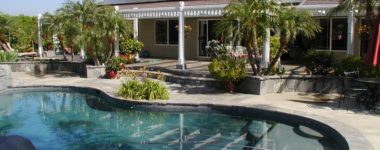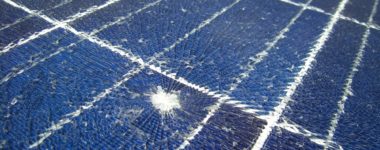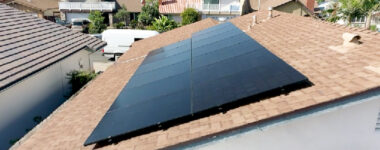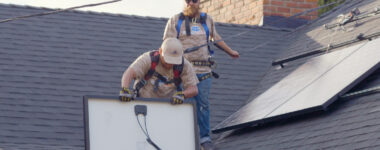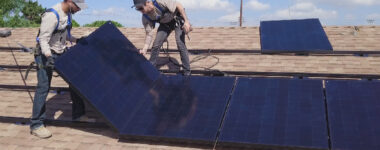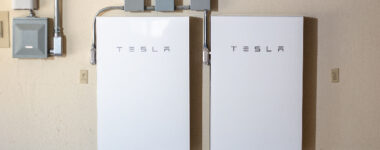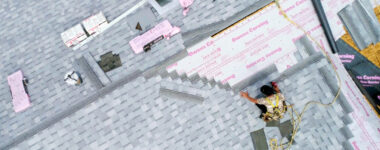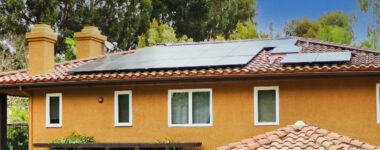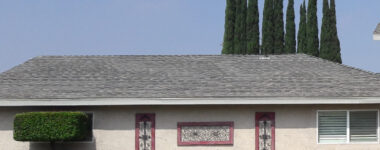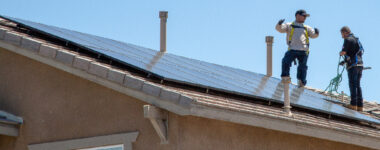Semper Solaris Blog
Most homeowners figure they need a new roof after they spot a leak in their ceiling. This leak could be due to many different roofing problems. But, what factors really determine whether a Roof Installation will solve the problem or the house needs a roof replacement? Here are some tips to help you determine if you need a new roof: Roof age How old is your existing asphalt shingle roof? Most experts agree that a typical roof will last between 20 and 25 years. It also depends on whether the old roof was removed and you only have one layer of shingles, and if it is properly ventilated. If the roof was installed over another layer or several layers and it is older than 20 years, chances are you need a new roof. Shingles curling and buckling Shingles that are curled or buckling are another sign that you may need a new roof. Look at the slopes of your home that get direct sunlight and if you notice the shingles are curling and losing granules, it could mean the shingles are past their life expectancy. There could also be a possibility that the roof is defective. Roof valleys If your roof shingles are falling apart or missing in this area, it's a definite sign you need a new roof. Valleys are one of the most important areas of your roof. Snow and rain flow through valleys and into gutters. If the valley is compromised, you could be susceptible to roof leaks. Missing shingles These are another sign your roof could be failing. Check to see if all of the shingle “tabs” are intact. Chimney flashing This is another area to be concerned about. If your flashing consists of roof cement or tar, it may need to be replaced with a long-term, water-tight fitting, which would be a metal flashing system. Shingle granules in the gutters Look in your gutters to see whether they are loaded up with shingle granules. Roofs tend to lose more granules toward the end of their life cycle. Inconsistent or darker color on some parts of the roof is another sign the granules have worn away. Daylight through the roof boards You notice a spongy feel or trampoline bounce when walking on the roof, which means the underlying decking is weakened from moisture. Check your attic to see if there is any daylight coming through the roof boards. Also check for moisture in the insulation.
Renewable energy is a necessity that is slowly being appreciated by everyone today. There are a growing number of homes, buildings, outdoor establishments that utilize solar batteries. With the rising cost for service necessities, such as electricity, people are slowly moving to newer sources for energy. Solar batteries have been out in the market for those who wish to cut on expensive costs of electricity. Solar batteries are used to store electric energy with the utilization of solar panels to capture sunlight and convert it to renewable energy. The process in which electricity is made possible by solar batteries is simple, it absorbs solar light, collects proton energy, and triggers electrons that eventually creates energy. Electricity is then stored in these batteries allowing energy to be used whenever it is needed. You may be wondering why you should even consider shifting from traditional sources of electricity to those powered by solar batteries. There are important factors which you should consider, thus allowing you to appreciate its advantages: Low electricity bills Rising costs in electricity bills only get worse with time. The reason for this is that resources are becoming scarce and the population of people is not getting any smaller. Solar batteries are able to supply electricity to appliances needed to survive everyday life. Examples of these appliances are cooking stoves, cooling systems for houses, heaters, lights for both indoors and outdoors. Low contribution to pollution Solar batteries do not contribute to pollution. They are renewable energy that does not emit harmful toxins that destroy our environment. It collects energy that is needed by you, and collects once more when energy is depleted. Unlimited supply of electricity With the integration of solar batteries used by homes today, electricity can now be stored in greater numbers. These batteries have the capacity to store certain amounts of electricity depending on the model you purchase from your local dealer. Free source of power Sunlight is the main source of energy which solar batteries derive their power from. As long as the sun keeps shining, your batteries never run out of power. The beauty of sunlight is that companies cannot create business from everyone using sunlight. Portable energy Solar batteries are capable of transportation for use in the most obscure areas. Unlike traditional power sources, solar energy can be used anywhere. As long as you have the solar batteries and the sun keeps shining then you're good to go!
Nearly all photovoltaics installed are made up of some kind of silicon; however, solar panels can be made up of a wide range of silicon variations, from monocrystalline to polycrystalline. Why does this matter? Depending on how pure the silicon is, solar cells can better convert sunlight into electricity. Obviously, this means that panels that are considered the most efficient will likely be made up of the purest types of silicon. This also means higher price tags – which is why efficiency isn’t the only factor to consider when it comes to selecting the right type of solar panel for your property. Factors such as cost, amount of space needed, and actual energy needs can also help determine the best option. We are going to compare three of the most common solar panel types below. Keep reading to get informed before going solar. Polycrystalline Solar Cells First introduced in the 1980s, polycrystalline silicon solar panels are made by melting raw silicone and pouring that melted material into molds. Once cooled, they are cut into square wafers, making it a much simpler process compared to other solar panel types, especially monocrystalline. This also means that polycrystalline panels tend to be more affordable as well. However, they typically have less tolerance towards heat than monocrystalline panels. While this could mean a greater wear and tear over time, the amount is so small it usually isn’t even taken into account by buyers. These panels have an efficiency of 13-16% on average, which is lower than monocrystalline solar panels since they are not as high in purity levels. That also means you need to cover more space to get equivalent energy generation. Monocrystalline Solar Cells Known to be some of the purest silicon-based solar panels, monocrystalline boast a uniform appearance and coloring. This is because of the high-purity silicon they are made from. The design is made to not only lower costs of a single solar cell, but also maximize the space, making it as efficient as possible. Efficiency ratings tend to range from 15 to 20%, putting them above polycrystalline solar panels. SunPower, our trusted solar panel provider, is known to produce the highest efficiency monocrystalline solar panels available on the market, reaching a record-breaking efficiency rate of 22.8%. These panels are also very space-efficient and durable, taking up the least amount of space while yielding high outputs of power. All these advantages do come at a cost, making monocrystalline panels the most expensive investment. Thin-Film Solar Cells This option is a little different than the former two, made by layering thin layers of photovoltaic material onto a substrate. Materials used to make these solar cells can range from amorphous silicon to copper indium gallium selenide. Maximum efficiency for thin-film panels caps out around an optimistic 13%. Improving modules are expected to reach as much as 10 to 16% over time. While the mass production of these types of solar panels is easier and possibly more affordable than crystalline competitors, efficiency levels don’t compare just yet. Also, they are typically more flexible and aren’t as impacted by shading, high temperatures, and other factors like crystalline-based panels are. Unfortunately, these panels are not yet ideal for residential spaces, as they tend to take up a significant amount of space. While the panels are more affordable, due to the lack of efficiency, supporting materials tend to add a significant amount to the total cost. Get Expert Advice on Solar Panel Selection Think it’s time to call in the experts? Semper Solaris is a veteran-owned and operated company that cares about our customers. We want to make sure you get the right solar panel type for your specific property and budget. Talk to us today about how going solar could work for you!
The summer days are heating up in San Diego, which means it’s time to shimmy into your favorite swimsuit and enjoy your backyard pool! We San Diegans love our pools, and with good reason! What better way to relish our gorgeous weather than to lay out by the pool, float on a raft, or invite friends over for margaritas and cannonballs? However, owning a pool comes with a price. That includes both the price you’ll see on your electric bill and the environmental price of your energy-hungry feature. Residential solar in San Diego can help you lower your energy bill and your carbon footprint without giving up your relaxing outdoor oasis. Let’s look at what a pool is really costing you and how solar panels can help! A Popular California Pastime Do you absolutely love your background pool? We get it. Pools offer a perfect, screen-free activity for the kiddos, especially during the summer months when they’re out of school. A pool can also increase your status as the host-with-the-most when you hold family gatherings, invite the neighbors over for some BBQ, or just want to catch up with friends. You are not alone. California is home to the most residential pools in the entire country. According to The Association of Pool and Spa Professionals (yes, there really is an association for everything), roughly 1.23 million Californians own a residential pool. Another 1.12 million own hot tubs just for good measure. All those pools and hot tubs require a lot of energy. No doubt you’ve noticed the big jump in your energy bills whenever you start up the water pump and heater. How much energy does your greedy pool require and what is that doing to your bottom line and to the environment? An Energy Gobbler All of your appliances and electrical products require energy, but your pool is a particularly hungry beast. Aside from your air conditioner, your pool is likely to be the biggest energy user in your home! The amount of energy your pool uses will depend on a variety of factors, including the size of your pool, the equipment you use, how actively you maintain it, and whether the pool is also heated. Still, averages can be helpful. According to Think Progress, the average pool contains 20,000 gallons of water. It takes a lot of energy to filter and clean that much water and to keep it warm if you have a heat pump. ThinkProgress cites a study by Opower (which has since been purchased by Oracle) that found pool pumps can use up to 2,500 kilowatt hours (kWh) to circulate and filter water each year. More recently, Canstar Blue, a consumer review site in Australia (where pools are almost a necessity during the sizzling summer down under), estimated that the average pool requires between 2,000 and 3,000 kWh of energy per year! Just to put that number into a little perspective, running your clothes washer for two, hour-long loads per week will require just 26.5 kWh per year. A desktop computer running 10 hours every day of the year will only need 273.75 kWh per year. You could keep your LCD television on 24 hours a day, 365 days a year (though we don’t recommend it), and it would only take 1,314 kWh per year. That still pales in comparison to the amount of energy your pool is slurping away right now. (These numbers are brought to you by this nifty energy calculator from the U.S. Department of Energy.) In other words, your pool is energy expensive, which means it’s also expensive when it comes to dollars and cents. Are You Getting Soaked? Your pool is an investment. All that water isn’t free. Neither is pool equipment, like the water pump, or the cleaning products you need to buy on a regular basis. If you hire someone or pay your kid to clean the pool each week, that’s just another big expense. What you might not realize is that your pool is costing you in another way. If you’re wondering why your electric bills suddenly rocketed up the month after you turned the pool on, just glance into the backyard and you’ll have your culprit. Pool manufacturer River Pools and Spas helpfully breaks out the monthly electrical costs of common pool systems: $30 - $50 for a two-speed or variable speed pump/filter system $75 - $150 for a one-speed pump $50 - $250 for a heat pump $100 - $300 for an in-ground hot tub In a best-case scenario, if you don’t heat your pool, don’t have a hot tub, and have invested in a variable speed pump, you’re still looking at $360 to $600 a year just in electricity costs to maintain your pool. In a worst-case scenario, if you have a one-speed pump, a heat pump, and a cozy hot tub to complete your backyard empire, your energy costs could increase by as much as $8,400 a year! That’s a pretty serious expense even a relaxing day by the pool might not be able to make you forgot. Of course, it’s also worth remembering that energy has a price beyond money. Your pool is also taking an environmental toll. The Carbon Cost of Your Pool Unless you’ve already invested in residential solar in San Diego, the energy needed to power your pool comes from a public utility company, like SDG&E. California and San Diego are doing a great job of getting more and more of their energy from renewable resources, especially solar, but a majority of it still comes from fossil fuels, like natural gas and coal. Turning these fossil fuels into energy releases carbon dioxide into the environment, which contributes to climate change. Energy-hungry home features, like your pool, can play an outsized role in increasing your home’s carbon footprint. The Carbon Fund, which sells carbon offsets, calculates that every kilowatt hour of energy results creates roughly 1.22 pounds of CO2. By this calculation, a pool that requires 2,000 to 3,000 kWh of energy per year will produce approximately 2,444 to 3,666 pounds of CO2 annually. Even on the low end, that’s more than a metric ton of CO2 released into the atmosphere each year. If you care about fighting climate change, your pool may be undermining the hybrid car in your driveway, the low energy appliances installed throughout your home, and the other efforts you’ve made to lower your carbon footprint. Does this mean that it’s time to close your outdoor water sanctuary forever in order to rescue your budget and save the world (at least a little bit)? Before you turn off that water pump and drain away your kids’ favorite summer activity, consider a few options that can lower or even eliminate the energy costs of your pool. How to Lower the Energy Needs of Your Pool There are a variety of ways to lower the energy your pool requires. Let’s start with the small changes: Use a Pool Cover One of the easiest and least expensive ways to save energy is to buy (and use!) a cover for your pool. A cover prevents water from evaporating, which will also help you conserve water – a big deal in drought-sensitive San Diego. Evaporation also leads to significant heat loss, which can force your heat pump to work overtime (and drink up more energy). Buy a Variable Speed Pump The majority of pools in the United States use a single speed pump. As its name implies, the single speed pump only has a single setting. Because it can’t be dialed up or down, it always operates at maximum capacity. Though single speed pumps are less expensive upfront, they require a huge amount of energy. You’ll save money and energy in the long run by paying a few hundred dollars more for a dual speed pump, or ideally, a variable speed pump, which uses the least amount of energy. Maintain Your Pool Equipment A clogged or poorly performing filter will force your pool’s pump to work harder than it needs to, which will increase its energy needs. Clean your filter regularly, assess your pool equipment, and make sure the water’s pH is balanced. If you have to hire a company to maintain your pool, it could be money well-spent if it keeps your energy bills down and your family safe. These are the small updates you can make to lower the energy your pool requires, but if you want to go big and possibly eliminate the energy and environmental costs of your pool altogether, you only have one option – solar panels. One More Reason to Consider Residential Solar in San Diego If you are already considering solar panels as a way to eliminate your entire electric bill each month, then the high energy costs of your pool are just one more good reason to go solar. With the right sized solar system, you could save hundreds of dollars each month on your energy bills. In fact, the average solar panel system in San Diego pays for itself in just four to five years! After that, it’s savings all the way. Don’t forget that you’ll be saving big in another way. By investing in the clean, renewable energy of the sun, you can help keep over a metric ton of CO2 out of the atmosphere each year, and that’s just for the energy needs of your pool. If you like to crank the air conditioning during the summer months or have an electric car to charge each day, you could lower your carbon footprint even more! All of these reasons make residential solar in San Diego worth considering for pool owners and all homeowners in America’s Finest City. If your pool is humming and your electric bills are climbing, contact Semper Solaris today to schedule a free energy consultation.
A solar panel system for your home is no small purchase, so how can you make sure to protect such a big investment? The good news is that top-rated solar panels are designed to withstand heavy winds, punishing rainstorms, mounds of snow, sizzling summers, and freezing winters. In other words, solar panels are pretty durable! The vast majority of solar panel systems can operate for decades without a problem, but that doesn’t help if you happen to be in the small minority of customer to receive a faulty panel. That is why solar panel warranties should be an important factor in your solar purchase decision. What types of warranties do solar panel manufacturers offer, and how can you effectively evaluate different types of solar warranties? Why a Solar Panel Warranty Matters It isn’t exaggerating to say that a solar panel system is a multi-decade investment. But although it might seem like a lot of money, solar panels offer savings in the long run by dramatically lowering or eliminating your monthly electric bill. (They also increase the value of your home!) The tradeoff of an upfront investment in exchange for net savings over time depends upon a solar system that functions as promised. If your panels fail, or if their efficiency quickly diminishes over the years, then you’ll never get the savings you expected. A solar panel warranty is a guarantee that your solar system will operate as advertised so that you can enjoy the savings you were promised. Too often, when customers compare different solar panel models, they only look at upfront factor: the efficiency of the panels and the price tag. It’s easy to overlook the value of a warranty because it only comes into play when something goes wrong. Don’t make this mistake. A warranty is a valuable feature of a solar panel brand and should definitely factor into your solar panel purchase decision. The Different Types of Solar Panel Warranties When you start shopping for solar panels, you’ll discover that top-rated solar panels offer more than one type of warranty. The two more common types of warranties are the product warranty, which covers all the parts of the solar panel and the performance warranty, which guarantees a certain level of performance over time. Additionally, you may be able to snag warranties on other related parts, including a warranty on your system’s inverter and on a solar battery. Let’s look at each of these warranties in more detail. What Is a Solar Panel Product Warranty? Solar panels are designed to take a lot of punishment from the environment, but sometimes even they fail. A product warranty (also called a materials warranty), covers the integrity of each of your solar panels. Product problems can occur as a result of: Manufacturing defects (such as faulty wiring) Corrosion Other types of premature wear Environmental issues Many solar panel manufacturers offer 10-year product warranties. Top solar panel companies like Panasonic offer a 25-year product warranty. Consider the added value that longer warranties offer. A typical solar panel would cost you a small amount to replace out-of-pocket. A 25-year warranty protects your solar investment for 15 years longer than a more standard 10-year warranty. In fact, a 25-year warranty will essentially guarantee the integrity of your panels for the life of your roof. Keep in mind that a 25-year product warranty also signals that a company has extremely high confidence in the quality of their product. How to Use the Warranty If you notice that a solar panel or multiple solar panels aren’t working, your first step should be to contact your solar installation company. If they determine that a solar panel is faulty, then it’s time to reach out to the manufacturer. If all goes smoothly, the manufacturer will ship a new panel or panels to you. Ideally, they will also cover shipping and installation costs. What Is a Solar Panel Performance Warranty? As with almost all technological products, solar panel performance degrades over time. Each year, a typical solar panel loses about 0.7% of its efficiency. This means that, over time, your solar panel system won’t be able to produce as much electricity as it did in its first years. (Youth is so fleeting!) Solar panels lose efficiency at a relatively reliable rate, which means that manufacturers are able to anticipate the rate of loss and offer a performance warranty to protect against extreme degradation. Performance warranties guarantee a certain level of performance over a certain amount of time. For example, a typical performance warranty will guarantee 90% of production for 10 years and 80% production for 25 years. When evaluating a performance warranty, it’s important to also understand the efficiency rate of different solar panel brands. For example, even though Panasonic and KYOCERA solar panels both offer an 80% production warranty over 25 years, Panasonic’s maximum efficiency rate is 21.6%, while KYOCERA’s max efficiency rate is only 16.1%. How to Use the Warranty It can be tricky to tell if your solar panels are losing performance at a faster rate than what the warranty guarantees. If you notice a sudden dip in energy production, it’s most likely to be an issue with the panel materials. However, if your panels seem to be producing noticeably less energy over time, then contact your installation company for an assessment. If they feel that performance is the issue, then contact the manufacturer who should provide you with replacement panels. Some manufacturers will cover the shipping and replacement costs. Other Product Warranties You may also be able to receive a warranty on your solar system’s inverter and solar battery. An inverter is a device that changes the direct current that your panels produce into an alternating current, which is what all of your electronic devices need to function. Without an inverter, your solar panels would just be odd roof decorations that create a form of energy you couldn’t use! Inverters typically don’t last as long as solar panels, and most homeowners have to replace a system’s inverter at least once over the life of the system. As a result, inverter warranties tend to cover a shorter time than solar panel product warranties. Most inverter warranties last between five and ten years. The other type of warranty you may be interested in is a solar battery warranty. Solar batteries are increasing in popularity as they become more reliable and cost-effective. Solar batteries allow you to store the excess energy your panels generate for use at night or during other times your panels aren’t operating at peak efficiency. They can be useful if you live in an area without reliable utility power, or if you are making an effort to live off the grid. Most battery brands offer a warranty of five to 10 years, and you can expect top solar batteries to last around 15 years. Don’t Void Your Warranty! Investing in top-rated solar panels with the best warranties won’t help you one bit if you do something that voids your warranty. Read the fine print of the warranty document to ensure that you don’t put your warranty at risk. Generally speaking, you may void your warranty if you or an unlicensed worker modify or repair your system, or if you don’t provide basic protections to your system, like cutting back trees. Unrelated mistakes, like stepping on your system while putting up Christmas decorations, also won’t be covered by your warranty! It’s always a good idea to reach out to your original solar panel installation company if you notice a problem with your system. Make sure that a licensed installer assesses your panels and provides any needed modifications or repair in order to maintain your warranty. Choose Top Rated Solar Panels with Great Warranties A solar panel warranty isn’t useful… until it is! That is to say that a warranty can become extremely valuable if something goes wrong with your system. Most systems operate flawlessly, but it’s always smart to have a Plan B just in case. Your warranty is that Plan B. The better the warranty, the more protection you get on your solar investment, so consider paying a little more for top industry warranties. At Semper Solaris, we work with a wide variety of solar panel brands (unlike many other installation companies that only offer one or two brands). We are happy to provide solar panel recommendations and to help you choose the right solar panel for your roof, budget, and energy needs. Contact us for a free solar panel assessment today.
If you have noticed solar panels showing up on private homes a lot lately, you've likely wondered if the cost of solar panels in California is worth the significant investment they represent. While it's true that the cost of solar panels can be quite high, the truth is the potential savings they can net you on your monthly electric bill make them worth the initial investment. In fact, when you compare the amount of money you can save on an annual basis and compare that amount to the cost of solar panels, California homeowners may find themselves pleasantly surprised. The easiest way to factor the value of going solar is determining how much you pay for your current electricity from a local grid on a monthly basis compared to how much you can get paid for the electricity produced from PV after those initial costs are deducted over the course of the system’s lifetime. This total is the amount that should matter to homeowners when they consider whether or not solar can save them money. Caught up in this big picture approach is the idea of solar grid parity. What exactly is Solar Grid Parity and how does it affect me? So what exactly is solar parity and how does it affect the decision to go solar? It is the point at which the amount of money needed to produce power from solar panels is either equal to or less than the cost of paying for electricity from the grid. The sooner we get to solar parity across the country, the cheaper it will continue to get. Essentially, the more people recognize the benefits of solar and choose to invest in this renewable energy source, the sooner it will become adopted across America, making energy cleaner and more affordable for homeowners. How does this work? When solar companies can buy in bulk to meet the growing consumer demand for solar panels, they can lower the cost of solar panels. California homeowners, for example, may find they get better prices on materials. This impact also boosts investment in transmissions lines and helps to cut solar costs, which means it can meet the rising cost of electricity sooner, resulting in parity, or equality, until solar eventually becomes even cheaper. How Close Is the U.S. to Solar Parity? What is the timeline for solar parity in America? That answer depends on a number of factors, with each state facing different challenges, from limited sun exposure to transmission line investment costs. The country has set a target of boosting renewable energy usage to 20 percent by 2040, which would likely result in solar parity nationwide. While we have some ground to cover as a country, California is leading the way as one of the 20 states at grid parity. Weighing the Cost of Solar Panels: California Homeowners Should Be Going Solar Now The point of parity on the grid has already been reached in California, which means installing solar panels is now more affordable than the average electricity bill homeowners have to pay off every month. Solar isn’t just an option for investing in the future of affordable energy; it can start saving homeowners money right now. The average homeowner will cut back on costs between 20 and 40 percent – especially when the individual chooses to partner with a company like Semper Solaris. With zero down and zero out of pocket, solar energy has never been more affordable and realistic for homeowners. Factors that make going solar affordable to homeowners now include the following: You receive a 30 percent federal tax credit. Net metering can result in money back from electricity companies. California has already reached grid parity. Great savings exist in Semper Solaris’ online specials. Some properties may go months without having a bill. The interest is tax deductible. Low income and low FICO scores can still finance through PACE. What Is PACE Financing? The PACE Financing program is a great option that makes setting up solar energy easier for homeowners, ultimately pushing us closer to solar grid parity. Short for Property Assessed Clean Energy, PACE is a financing option designed to help homeowners save money when investing in cleaner energy while adding more value to their property. PACE covers 100 percent of the solar installation cost and can be paid back over the course of 20 to 30 years, with an assessment added to the property tax bill. Homeowners start saving from day one! The Senate bill on PACE (SB-242) will add more consumer protections for residential PACE programs in California, providing even more peace of mind to homeowners wanting to invest in energy upgrades that wouldn’t otherwise be accessible to them. With California at solar grid parity, switching to solar is the smart investment for homeowners who want to instantly save on their energy bill and be a force for renewable energy!
Povas Miknaitis served in the Marine Corps for 6 years as a scout sniper. He served two combat tours, one in Afghanistan and one in Iraq. After his service, he became involved in the Warrior Foundation and also finished his education. He moved to Freedom Station after being released from the hospital. The team at Semper Solaris was excited to hear that The Semper Cares initiative will be helping a fellow marine by installing a new solar panel system for his home. On Independence Day, Povas received a new solar panel system, free of charge, by our Semper Cares Initiative, along with the Warrior Foundation Freedom Station. We are extremely proud of the men and women who have served our country, and Povas is among many who deserve the goodwill of others for their patriotism and their sacrifice. Though we may not be able to reach out to all veterans, our efforts along with our partners are offering all that we can to our veterans and our communities. [embed]https://youtu.be/7xOPN479QWM[/embed]
Drip, drip, drip… Your roof is trying to tell you something, and it’s not that you should consider installing a serene water feature inside your house. Normally, your roof is the strong and silent type, but as it faces the harsh elements each day, even the sturdiest roofs can start wearing down. It might be time to call a San Diego Roof Installation expert, but how do you find a reliable and trustworthy contractor? What will the Roof Installation entail, and, most importantly, what hit can you expect to your budget? Roofs last a long time, so many homeowners have rarely, if ever, needed a Roof Installation. If your roof is begging for help, you might not know what to expect during a repair or how to prepare for it. Not to fear! Here at Semper Solaris, we’ll walk you through the Roof Installation process step by step to determine if contacting a San Diego Roof Installation expert is necessary. Step One: Admit Your Roof Has a Problem If you’ve literally got raindrops falling on your head while indoors, it’s pretty clear that your roof is crying out for help. However, roof issues aren’t always so clear, especially from the ground. How do you actually know whether your roof has a problem that needs expert intervention? You don’t need to be a “roof whisperer” to figure out if you’ve got damage. Keep your eyes peeled for these telltale signs: Cracked or missing tiles or shingles Curling shingles Decay of shingles Blistering paint on the outside or inside of your house Blistering ceiling Stains or mold on the ceiling or walls Leaking from the ceiling, especially around fixtures, like vents, skylights, or chimneys Why Repair a Roof Roof Installations can be costly, and it’s not like anyone wants to spend their savings on home maintenance instead of taking the family to Legoland or SeaWorld. However, spending a little money to take care of a roof problem as soon as it presents can save you from a much bigger repair bill in the future. Roof damage doesn’t magically go away, it just gets worse. A small stain on the ceiling today could start growing mold tomorrow and dripping water onto your floors and furniture next week. Additionally, if you’d like to install solar panels in the next few years or so, you’ll definitely want to fix your roof before adding anything else up there. If you notice roof damage, start looking for Roof Installation companies right away! Step Two: Find the Right San Diego Roof Installation Company It’s always a little nerve-wracking to entrust your home to a new contractor, especially with something as important as your roof. If you’ve never hired a company to perform a Roof Installation, how do you find a trustworthy contractor that will do a great job? First, check out this article we published on how to find the best solar panel installers. Yes, this article is focused on solar installation companies, but the principles are the same. It’s a smart idea to visit the top crowdsourced review sites, including: Angie’s List The Better Business Bureau Yelp The best way to predict how a contractor will perform is to learn about how they’ve worked with other homeowners in the past. A terrible contractor with lousy reviews likely won’t magically change their stripes and do an excellent job for you! Step Three: Schedule a Roof Inspection Every roofing contractor worth their shingles should offer you a complimentary roofing inspection so that they can diagnose the problem and offer you a repair recommendation and a quote. We encourage you to seek multiple quotes to give yourself options. On the day of the inspection, the roofing company will send a trained technician to your home. The technician will ask you questions about what you’ve seen and experienced and will then assess the entire condition of the roof. The technician may walk on the roof, inspect your attic, and even assess the exterior walls and foundation of your house. Step Four: Understand Common Roof Damage After the assessment is complete, the technician will sit down with you and explain the issues that they noted and provide you with a diagnosis of the problem. Roofs tend to break down in similar ways, and the most common problems tend to be: Leaking Leaks are the most common roof problem that most roofing companies deal with, most likely because it’s also one of the most noticeable issues to homeowners! There are a variety of reasons that roofs can leak. In many cases, the culprit is an installation, like a chimney, skylight, or vent. It is common for the flashing around these installations to wear away, resulting in water eventually trickling through minute openings around the seal. Flashing can also corrode or crack with age, letting water make its way into the house, especially during heavy winter rains. One other common cause of leaking is improperly installed shingles or tiles. If a “handyman” tried to replace damaged tiles or shingles on your roof, they may have damaged the underlayer or the flashing of the roof. Damaged Shingles or Tiles Shingles or tiles can wear down over time, causing them to crack or fall off entirely. This exposes the inner parts of the roof to the elements, which can quickly result in leaks. Though San Diego doesn’t have much extreme weather (which is one of the reasons we love living here), we do get some pretty hefty winds during the Santa Anas, which can tear away loose shingles or tiles. There’s also always the risk of “blunt force roof trauma” from a falling tree branch! Age The age of a roof is often a contributing factor to damage. The older the roof, the more likely that its flashing, underlayers, and tiles or shingles will simply break down. A roof’s lifespan will depend on a number of factors, including: The quality of its original design and construction How well it’s been maintained Weather conditions Materials used Shingles, which are the most common type of roofing around the country, can last anywhere from 20 to 25 years. Many San Diego roofs use Spanish tiles, which boast a lifespan of 50 years or more. If your roof is nearing the end of its life, it may make more sense to replace the entire roof than to spend thousands of dollars repairing it. Step Five: Receive a Recommendation and Repair Proposal A good technician will sit down with you after their roof assessment is complete and lay out all of your repair options, including what will happen if you decide to ignore the problem. Depending on the nature of the damage, you may be presented with several possible fixes followed by the technician’s personal recommendation on what they consider to be the best option. For example, a roof technician may be able to repair the damage to your roof, but they may recommend replacing it if the roof is nearing the end of its lifespan or if the cost to repair the damage is only a little less than what it would cost to repair the roof. The technician should also be able to write up a proposal, which will – at long last – include a price quote for the recommended repair. The Cost of a Roof Installation So, how much will your Roof Installation cost? We might sound like a broken record by now, but the answer is that it depends! The amount of damage, the nature of the repair, and the unique characteristics of your roof will all affect the final repair price quote. For example, Spanish tiles are more expensive than asphalt shingles, so replacing a lot of Spanish tiles will be more expensive than replacing shingles even if the problem is the same. A small Roof Installation job may only require a contractor to replace and seal worn-out or missing shingles which can be very affordable. A medium repair job could include replacing shingles as well as sealing fixtures, like a leaking skylight. Oftentimes, the flashing around these fixtures also needs to be replaced. A moderate job can be a little bit more in price, sometimes more significant than smaller jobs. Large Roof Installations usually include fixing the underlayers of the roof, which requires the contractor to remove a good number of tiles or shingles (possibly all of them) in order to get to the underlayment, water barrier, and insulation. The contractor may even have to address damaged wood. At this point, your repair bill will set you back a larger amount and it may be worth considering a full roof replacement, which will be more expensive. A roof replacement is a costly project, but it is also an excellent investment in your home, especially if you would like to install rooftop solar panels in the future. If you do decide to move forward with a full roof replacement, we strongly encourage you to work with a company that is willing to offer you a warranty on their finished product. At Semper Solaris, we work with some of the very best roofing materials, including GAF and Owens Corning, which offers an outstanding 50-year platinum protection limited warranty. Step Six: Prepare for the Roof Installation A small or moderate Roof Installation may only take a day for a contractor to complete. A larger Roof Installation or a full roof replacement can last several days or even longer for larger homes. If you stay in the house during the repair, be prepared for disruptive noise. Not only will you hear feet walking on the roof over your head, but you’ll also get an earful of hammering and other noises as the workers replace roofing layers and put the shingles and tiles back on. It’s usually best if you can be out of the house during the repair, especially if you have young children who don’t appreciate loud noises. You may also want to consider taking skittish pets out of the home so as to not overly stress them. Step Seven: Enjoy Your Roof! After the repair, your roof should be as good as new. Or maybe it is all new! Either way, you’ll rest easier at night knowing the roof over your head is strong and complete. If you enjoyed working with your contractor, we encourage you to write them a positive review on the review site of your choice. Many local San Diego Roof Installation companies depend on word of mouth and positive reviews to generate new customers, so your positive words will be appreciated. Ready to get a diagnosis for your San Diego roof? Contact Semper Solaris to get a free roofing quote. Take a look at our current online roofing discounts. If you are considering installing solar panels, we do that too and offer big savings for combing roofing and solar services. Contact us to get your roof quote today!
There are an incredible 6.4 million people working in the energy industry in the United States, and a huge percentage of them are employed in clean energy. If you’ve ever purchased solar panels for your home or opted for a hybrid car, you’re doing more than saving money on utilities and gas. Clean energy is environmentally friendly and moves the country toward energy independence. And when you install solar, you’re also helping propel the creation of thousands of new clean energy jobs in America. What does a career in clean energy look like? Some of the fastest-growing careers in this exciting industry include sustainable builders, wind turbine technicians, and solar panel installers. The clean energy industry is booming from coast to coast, and it’s changing the way the country looks at heating its homes and keeping the lights on. It’s also giving talented workers from all walks of life a new career path. Here are just some of the inspiring facts about the sustainable energy employment trends -- and how solar panels are helping. 1. Clean Energy Jobs are Outpacing the U.S. Economy According to a 2017 report from the Environmental Defense Fund, both solar and wind industries create jobs at a rate 12 times faster than the overall U.S. economy. In 2016, solar jobs expanded an impressive 17 times faster than the total national economy. That year, 1 in 50 jobs added in the U.S. were created within the solar industry. As many workers in the country mourn the loss of coal jobs and other fossil fuel industry careers, clean energy is stepping in with a solution. Despite recent setbacks, including federal tariffs, solar panels are ever more popular. Between solar panels for your house and more efficient appliances -- you can support this job boom all while cutting your own energy costs. 2. Almost 1 Million People Now Work in Renewable Energy The number of people working in clean energy overall is about 4 million, and one of the fastest growing sectors is renewable energy. Renewable energy is any type of power without a finite limit, often tapping into natural resources like sun and wind. In early 2017, 777,000 people were working within the renewable energy sector. Solar energy is one of the leaders in renewable energy, and jobs grew almost 25% in just one year between 2015 and 2016. What are these renewable energy employees up to? Building wind turbines for large communities, installing solar panels for your home, and working with geothermal systems are some of the most common things people in renewable energy do every day. More than half of all solar jobs relate to the installation of solar panel systems on homes and commercial properties and the building of utility-scale projects. What’s more, the wages in renewable energy tend to exceed those in other non-farm private sector jobs. That means that as the U.S. gains independence from foreign fossil fuels, it is also creating livable wages right here at home. 3. Solar Panels for Your Home Support Solar Storage Jobs Clean energy jobs are moving beyond installations. In fact, energy storage and clean energy grids provided about 90,000 jobs as of 2016. Energy storage ensures that users always have access to their solar and wind energy on demand; if you’ve ever wondered how solar still works on a cloudy day, storage is a big part of the answer. Companies like Tesla are creating advanced solar batteries that can be installed along with your solar panels for solar-plus-storage systems. Most solar systems send their energy through an inverter that directs excess energy back to the grid (and offers an energy credit on utility bills). Solar storage allows you to keep excess energy at home instead of sending it to the grid. The types of jobs you’ll often see related to solar storage include storage engineers, product developers, and electricians. Of course, home solar storage also needs installation, creating even more evergreen jobs. Many cities around the world are operating on mostly renewable grids at large, so the need for reliable energy storage will only increase as this trend grows in the U.S. 4. Efficient Cars are Helping Revitalize the Auto Industry The U.S. auto industry was once looking quite bleak, but clean energy is helping breathe new life into manufacturing plants and giving drivers new energy-friendly options. In early 2018, Ford announced it was going “all in” on clean energy and hybrid cars and investing $11 billion into hybrid and electric models. This translates to more than a fleet of innovative cars on the road. The 2017 Energy and Jobs Report found that jobs related to hybrids, plug-in hybrids, and electric vehicles made up the vast majority of jobs related to alternative fuels and transportation. In fact, 198,000 employees are supported by this sector of the clean energy market. As more car manufacturers invest in clean energy, new blue-collar and sales jobs may begin to boom as well. If you’re in the market for a new ride, consider an electric or hybrid model to show your support for clean energy jobs in the auto industry. 5. The Number of Women in Solar is Rising Quickly Back in 2013, women held only 19% of solar jobs in the United States. By 2017, that figure had grown to 27%. Women make up more than half of the entire U.S. workforce, so there is still room to grow. Still, this exponential increase indicates a priority on inclusivity in the world of solar that is likely to continue. The Women in Solar Energy (WISE) non-profit strives to not only add more women and ethnic minorities to the world of solar, but also create an industry that leads the nation in policies that support families. With their help, the solar industry is poised to make huge strides in policies like fair maternity and paternity leave and generous sick leave. The bottom line is that the face of the industry is becoming more inclusive and it’s happening fast. Whether you’re ordering new solar panels for your home, or inviting an auditor to come out and evaluate your system, it’s becoming more likely that you will be greeted by a diverse team of professionals. 6. Job Gains Aren’t Just Happening in Warm Coastal States Solar is often associated with warm climates that are showered with more sunny days than they know what to do with. And it’s true that many warm climates remain at the top of the list when it comes to the adoption of solar. For instance, California remains the leader when it comes to solar installations and solar power usage. But did you know that many states throughout the country are giving coastal communities a run for their money? States typically not associated with alternative practices are making huge strides in clean energy and generating thousands of jobs as they go. In Minnesota, for instance, there are 160 solar companies and more than 116,000 homes are powered by solar. The Star of the North state has more than 4,200 jobs in the solar industry, including manufacturing and installation. Colorado boasts an impressive 6,700 jobs in solar and Tennessee has 4,400 solar energy jobs. Other states with a growing investment in solar include Utah, Nevada, and Nebraska.The nation’s leader, California, has an incredible 86,000 solar-related jobs. 7. Veterans Make Up Over 11% of Solar Workers A 2019 report shows that veterans constitute about 11.1% of the solar workforce in the United States. This figure is slightly higher than veterans’ overall employment in the country across all industries. What does that mean? Solar is a very welcoming industry for veterans and the solar community is making a concerted effort to transition service men and women into civilian employment back at home. Programs like Solar Ready Vets®, an effort by the U.S. Department of Energy, specifically aim to train outgoing members of the military for solar employment. In 2017 alone, 500 veterans were placed in solar jobs throughout the country via the Solar Ready Vets program. Veterans are doing everything from designing new solar grids to installing panels on homes and conducting maintenance on existing systems. Supporting solar jobs also means supporting your local veterans, including the the Southern California veterans that we hire at Semper Solaris! No matter how you cut it, the clean energy economy is a huge source for jobs in the United States. The industry is racking up new employees as it improves the environment and the quality of life for future generations. There are plenty of ways for you to support this industry as it cuts down on harmful emissions and promotes the future of energy. One of them is to buy new solar panels for your home! Contact Semper Solaris today to find out more about how you can support the veteran community while you update your home’s energy grid.
Imagine this scenario: A few decades in the future, your granddaughter (or great-granddaughter) wakes up in a home completely powered by solar power in San Diego. By that time, solar panel efficiency has far surpassed the 20% efficiency panels we have today. Even though the day is overcast, the panels on her roof still generate more than enough energy to keep all the electronics functioning in her home. During breakfast, your granddaughter glances at the news headlines and sees that, for the third year in a row, seasonal temperatures have dropped. This is good news after years of record-breaking heatwaves and big storms. It seems as if the significant worldwide drop in CO2 production is having a positive effect on the environment. Your granddaughter is driven to school in an electric car that was charged at home. It emits no CO2 into the atmosphere. During the trip, your granddaughter gazes out the window and doesn’t see anything strange in the fact that solar panels dot almost every roof. In fact, the roofs without solar panels seem out of place. At school, your granddaughter is asked to present a report on her family. She proudly explains that her father works in the solar industry as a warehouse manager. This job is what allows her to live in a beautiful home and enjoy the pleasures of life, like gymnastic lessons and a trip to Disneyland in the summer. Several of the other children in her classroom also have parents who work with solar in some way. That night, as the sun goes down, she flicks on the lights. Your granddaughter doesn’t think twice about firing up the computer to do her homework or turning on the television. Solar batteries like Tesla Powerwall are so good these days that they can power most homes using energy generated by the solar panels during the day. This is the solar future we are working for in San Diego. It may seem idealistic, but solar has come an incredibly long way in just the past decade. Most indicators point to the fact that the sector will continue to grow, advance, and mature. How far can solar in San Diego go? To answer that question, we need to understand what’s happening in the solar world today and what these trends portend for the future. San Diego’s Solar Push Transitioning from old to new technology doesn’t happen in a void. Whether or not a country, a state, or even a local city is willing to step up and support the transition can make a huge difference in its successful adoption. Fortunately, San Diegans live in the leading solar state and in a city that has put itself on an aggressive path toward adopting renewable energy. But before we can understand where we’re going with solar energy in San Diego, we must first appreciate how state and local legislation affects these efforts. The Clean Energy & Pollution Reduction Act In 2015, California put the rest of the country on notice when Governor Jerry Brown signed Senate Bill 350. The Clean Energy & Pollution Reduction Act requires the state to generate half of its electricity from renewable sources by 2030. This is a highly aggressive goal, and yet California is currently on track to meet it 10 years early according to an annual report submitted by California regulators! It’s worth mentioning that in 2017, a bill that would require California to produce all of its energy from “100 percent greenhouse-gas-free” sources by 2045 was only narrowly blocked. Many of the bill’s supporters vowed to present it to legislators again in the near future. Solar Panels on All New Homes Just because California isn’t quite ready to go 100% into renewable energy doesn’t mean the state has lost its appetite for bold initiatives. The Golden State proved this earlier this year when the California Energy Commission unanimously voted to require that all new housing built in the state after January 1, 2020 include solar panels. Not only will California residents start seeing a whole bunch of additional solar panels on roofs in new housing complexes, but a CEC press release explained that the new standard will also “reduce greenhouse gas emissions by an amount equivalent to taking 115,000 fossil fuel cars off the road.” San Diego Vows to Go 100% Clean Energy California prides itself on being a renewable energy leader, but the Golden State may need to take a backseat to its second-largest city. That’s because San Diego is going all-in on its renewable energy bet. In 2015, America’s Finest City became the first municipality in the United States to commit to transitioning to 100% renewable energy as part of a larger Climate Action Plan. And so far, the city is walking the walk. In 2016, the city’s public utility, San Diego Gas & Electric, reported that renewable sources accounted for an impressive 43.2% of its electricity production. Where Solar Power in San Diego Is at Right Now San Diego has set itself a challenging goal of generating all of its energy from renewable resources in the future. Solar energy will certainly play a central role in helping the city hit that goal. If you’ve lived in San Diego for the past decade, there’s no doubt that you’ve noticed solar panels popping up on more and more houses. What is the current state of solar in our city, and what can these trends tell us about the future of solar energy in San Diego? Solar Continues to Grow Across the Country but Dips in California It looks like the rest of the country is beginning to catch up to San Diego and California in adopting solar. According to the Solar Energy Industries Association (SEIA), in 2016, solar energy capacity grew more than any other energy source for the first time. SEIA estimates that in the next five years, the U.S. solar market will triple in size. A big portion of this growth will happen outside of California as other states dramatically increase their solar capacity. While San Diego may not see the red-hot growth in the solar market that it did in previous years, at least some of the national growth can be attributed to California’s example. Our state and our city has been a willing role model in how to embrace and incorporate solar energy into our current energy infrastructure. Solar Prices Keep Dropping One major driver in the growth of solar panels has been the speedy drop in price. As solar panels have increased in popularity, more solar companies have jumped into the fray to meet consumer needs. This has encouraged economies of scale as manufacturers become better at making solar panels, as solar technology improves, and as competition rises among solar installation companies. As the price of solar panels comes down, more homeowners and utilities will be enticed to invest, which will drive even greater competition, technological improvement, and economies of scale. In other words, solar will just keep getting better and cheaper! Solar Puts San Diegans to Work It takes a lot of talented people to run a successful solar company. Trust us, we know! Solar energy doesn’t just benefit a community by cutting down on pollution. It also puts local people to work. According to the Solar Foundation, the solar industry employed over 250,000 people in 2017, an astounding 168% increase from 2010. The Solar Foundation also notes that, “Solar makes up just under 2% of overall U.S. energy generation, yet it employs twice as many workers as the coal industry, almost five times as many as nuclear power, and nearly as many workers as the natural gas industry.” Here in San Diego, 7,934 of our friends, neighbors, and family members made their living in the solar industry in 2017. Solar jobs are uniquely valuable because they offer a living wage and most don’t require a bachelor’s degree. Solar companies are also a great option for veterans. Roughly one-in-ten solar worker is also a veteran, according to the Solar Foundation. Here at Semper Solaris, we are a veteran-owned company that makes a special effort to hire veterans in the San Diego community. As solar installation continues to grow across the country, solar jobs will grow with it. The solar industry will continue to offer new generations of Americans a fair wage and a middle-class lifestyle no matter their background! What’s on the Line Whenever we discuss the future of solar power in San Diego, we must take a step back and appreciate why our city and our state has gone through so much trouble and pushed so hard to free itself of fossil fuels. According to the EPA, the electric power sector accounted for 32% of U.S. total greenhouse gas emissions in 2012. Those numbers have increased by over 10% in the last ten years. The scientific consensus tells us that fossil fuels contribute to climate change, which in results searing heat waves, choking smog, more intense storms, degradation of wildlife habitats, and the increase of insect-borne illnesses, like Lyme disease and West Nile virus. Here in San Diego, we are already feeling the effects of climate change as our state suffers from more severe droughts and increasingly catastrophic fires. Solar energy is one potent option to fight climate change. In a massive 2015 study called, “The Future of Solar Energy,” the MIT Energy Initiative explained that, “Massive expansion of solar generation worldwide by mid-century is likely a necessary component of any serious strategy to mitigate climate change.” Every solar panel that goes up on a rooftop creates energy that doesn’t have to be produced by burning natural gas or by coal. If we want to preserve our beautiful planet for future generations, solar energy in San Diego can be a part of that solution. The Future of Solar in San Diego Remember at the beginning of this article when we described your future granddaughter’s solar-powered day? When you read that scenario, it may have seemed far-fetched or naively optimistic. However, the political decisions that California and San Diego are making today will help pave the path to that future. So will the manufacturing and technological trends that are quickly upping the efficiency of solar panels while dramatically cutting their costs. Finally, renewable energies offer one of the most effective ways to combat climate change. The decisions each of us makes can bring your grandchild’s future to fruition. If you want to combat climate change and protect the environment for future generations, it’s time to consider investing in your own solar-powered future today. At Semper Solaris, we want to help you decide if solar is the right choice for your home and budget. Contact us today to schedule a solar consultation.
Having a solar panel system installed can be an environmentally and economically savvy move. In fact, the Solar Energy Industries Association reported that the market doubled in 2016 compared to the previous year. Solar power is not a fading trend – it is here to make the world a greener place. With the wave of solar power comes additional renewable energy options for homeowners, including options like solar batteries for storing solar power not used right away. What Exactly Do Solar Batteries Do? When a homeowner has a solar energy system installed, it includes solar panels, mounting equipment, a monitoring system, and an inverter to make the power from the sun usable electricity in a home. Most homes are tied to an electricity grid, which means any additional or unused power created by your panels will flow into the grid. In return, homeowners are able to draw excess power needed when their solar panels aren’t producing enough (such as at night). Typically, a credit will be given to homeowners for any extra electricity their solar panels produce and send to the grid. That means these credits will usually cover any excess electricity needed to be drawn back from the grid when the panels aren’t generating enough power– also referred to as net metering. So what does this have to do with solar batteries? In theory, the batteries would take that excess solar power, convert it, and then store it for later use. The solar battery would then be the secondary power source your home draws from depending on how much power your solar panels produce. Any excess electricity produced by panels once the battery is charged is then sent back to the grid. It essentially gives your home an extra storage of usable electricity. If your solar battery is depleted when your panels aren’t producing power, only then will your home draw from the grid. Additionally, solar batteries can act as a quick backup power supply in power outage situations. Do I Need a Solar Battery for My Home? Having a solar battery may seem like a natural step to take when you have a solar panel system up and running for your home, but it isn’t always necessary. In large part, whether or not a battery is practical depends on how your utility processes the power produced by your solar panels. If you get compensated through a credit for every kilowatt-hour of electricity produced (net metering), a battery may not make as much sense. If a battery is storing that power, you won’t get any extra savings on your electricity bill. On the other hand, if you are under time-of-use rates or demand charges, you may benefit greatly from having the flexibility of a solar battery to provide previously produced power during those times. Also, if you like the idea of being able to store additional solar power and reducing dependence on the local electricity grid, a solar battery can be a great option. Still have questions? You can get answers when you trust your solar panel system installation to Semper Solaris. Contact us now to get more insight on how to go solar the smart way.
So you’ve noticed the signs that a roof replacement is needed. Now what? Figuring out how long a roof replacement is going to take can be important, especially if you want to get your home back and out of a construction zone as soon as possible. What to Expect During a Roof Replacement Project One of the most important things to remember – expect the unexpected. While your contractor will likely do their best to give you an accurate timeline, exposure to the elements means roofing projects can be impacted by all sorts of unexpected factors. Also, some projects may appear straightforward initially until a roofing contractor inspects the property and realize they have a much more complicated project on their hands. That means giving a concrete timeline for any roof replacement can initially be difficult. Of course, once your contractor has good bearings on your project, they should be able to break down an expected timeline for you so that you can plan accordingly. Factors Impacting Time for Roof Replacements On average, re-roofing a house can be as quick as a few hours to as long as a few weeks. What makes this timeline fluctuate so much? The following factors can greatly impact the time of a roof replacement project: Weather, including high winds Structure of a roof (steep areas vs. mostly shallow) Custom features such as chimneys or design elements Extent of damage Type of work being done (partial vs. total re-roofing) Local building codes and inspection requirements Materials being used (clay tile or slate vs. asphalt shingles) Generally speaking, a typical home re-roofing without any major days, homeowners should expect the project to last a few days. The best bet for an accurate timeline? Talk to several contractors about the specific details of your re-roofing project. Compare the different timelines and always allow several days for unexpected issues, like high winds, rain etc. Request a Quote for Roof Replacement Today Semper Solaris is proud to offer top quality roofing services to customers throughout Southern California and beyond. We understand that getting your home back in tip-top shape is your number one priority – which becomes our number one priority when you get our team on the job. We work efficiently and honestly for our clients, never delaying projects unnecessarily or keeping timelines vague. We want you to feel confident when you enlist the services of our roofers! If you are ready to get a quote for re-roofing your home, contact Semper Solaris today.
According to studies, San Francisco boasts a 62.6% higher cost of living than the average across the U.S. If you live in San Francisco or anywhere in the Bay Area, this probably doesn’t come as a surprise to you. Every day, you navigate the steeper prices for everything from groceries and gas to utility bills. You’ve also likely thought through options for cutting back on these expenses. Solar energy is paving the way for homeowners all over the country to save on their monthly energy spending – and nowhere is this more attractive an option than the Bay Area. With California’s booming solar market, the cost of going solar has become more affordable. Homeowners in the Bay Area have been getting system sizes averaging around 5 kW. This number may vary based on the size of your roof, overall household energy demands, and your desired budget. Taking into account the savings with rebates and net metering benefits, switching to solar may be more attainable than you realized. How Much Can Solar Really Save Me? As solar energy continues to grow, prices for solar panel systems will continue to become more affordable. However, waiting for prices to dramatically drop before making the switching isn’t necessarily the best way to save. The long-term savings you can take advantage of can be big – with an average homeowner in San Francisco on track to save an average of $59,416 over a 20-year period. These savings can range based on system size, however, the numbers are still too good to pass up. If you are trying to determine if going solar can help you save, let Semper Solaris help. Our trusted Bay Area solar company can review your options and help you understand which system is right for your needs.
If you are getting ready for a roofing project, whether a complete overhaul of an old roof or a new construction project, knowing the best materials for the job is crucial. That’s why Semper Solaris has provided you with a guide to understanding the pros and cons of some of the top roofing materials out there, from your classic shingle tiles to modern metal roofing options. Concrete & Clay Tiles A California classic, clay and concrete tiles are known to add elegance, texture, and style. While classic clay tiles are very heavy (and durable as well) and more expensive, concrete tiles can be used as a more affordable alternative. Either option provides homeowners with a stylized look and long-lasting roofing materials, averaging 40 to 50 years. Concrete tiles are actually energy efficient, providing more incentives for homeowners. These perks do come with the added cost of specially trained labor (due to the heavier weight and complicated installation). Asphalt Shingles Known to be one of the most used for homes, asphalt shingles are a classic choice. Why? These shingles are very affordable and rather straightforward to install. They also are available in a range of colors to suit a homeowner’s specific style preferences. The average lifespan of asphalt shingles is anywhere from 20 to 25 years, making it one of the shorter lifespans, and also doesn’t offer as much insulation as other, more durable roofing materials typically do. Slate A more unique option, slate roofing is known for being durable, sustainable, and beautiful. Color options can range from green, red, black, and more, giving homeowners flexibility to create their ideal Colonial or European style chateau home. While being very sturdy, slate is also very heavy and can require additional framing. The cost for slate is also typically higher than other more basic roofing materials. However, slate roofs are known to last anywhere from 50 to 100 years, boasting great durability. Metal Roofing Both a modern and classic appeal, metal roofing can be stylized in a variety of ways, from contemporary to rustic. This material holds up very well in harsh weather conditions, whether in the form of panels or shingles. Homeowners can choose from copper, zinc, aluminum, and stainless steel for their metal roof. While metal roofing can be more expensive, it does offer great solar reflectance and tends to last longer than asphalt options. Synthetic Options Growing in popularity are synthetic roofing materials, which can offer the beauty and style of classics like slate and wood shingles, without the same level of maintenance or price tag. Synthetic materials are also typically designed to be fire-resistant, providing greater protection for homes. Due to the relative newness of these materials, they aren’t as tried and true as older options; however, most come with warranties for up to 50 years or so, depending on the manufacturer. Weighing Your Options Before deciding on the material you want to use for your next roofing project, make sure you think through some key details. Some of the things you should consider include the weight of the material you select, and if your current structure can properly support that weight. If not, additional construction may be necessary. Another detail often overlooked is building and fire codes for local areas – talk with your roofing contractor ahead of time to ensure you are completely complying with all codes. Other details to think through include style options available in the material you like, average lifespan, warranties, proven performance based on region, and special maintenance requirements. Once you’ve worked through all of these details, you can have confidence knowing you have selected the best material for your project. Still not sure what materials to go with? Talk with your local roofer, Semper Solaris, to get professional insight today.
The kids are out of school, and the major holidays are still in the distance. No wonder summer is the prime moving season. You might not be ready to pack up and go quite yet, but seeing as the average American moves roughly 11 times in their life, chances are good you won’t be staying put forever. In the spirit of “moving season,” now is a great time to consider home upgrades, like solar installation, a kitchen remodel, and finally doing something to the patch of grass out front. The beauty of taking on a few big summer projects is that they can add value to your home and your life. You’re investing in your biggest asset and improving your domestic bliss! That’s a win-win. Let’s take a look at some of the most valuable home improvement projects to consider this summer (or any time of the year). Solar Installation We’re a solar installation company, so of course we think adding solar to your home is a great financial move. Don’t just take our word for it, though. According to a study from the Lawrence Berkeley National Lab, “home buyers consistently have been willing to pay more for a property with PV [photovoltaic solar panels] across a variety of states, housing and PV markets, and home types.” The researchers compared data on over 3,000 homes with solar panels with 18,871 homes without across eight states, including California. They found that solar panels conferred a value of approximately $4 per watt to the home’s worth. That means that a 5 kilowatt system (a system that produces an average of 5,000 watts a month) could add roughly $20,000 of value to the sales price of a home! That means your solar system will more than pay for itself when you sell your home, while also saving you money each month on your energy bills while you live in the home. We might be just a touch bias, but we think that’s a pretty good deal! We should note that the Lawrence Berkeley National Lab study only looked at homeowner-owned solar systems and did not provide data on leased solar systems. Remodel Your Kitchen Consumer Reports says it all when they proclaim, “kitchen is still king!” Professional millennial couples as well as baby boomers eyeing their retirement years want a beautiful, open kitchen with state-of-the art appliances and plenty of counter space to let them entertain and whip up dinners for the whole family. Before you start sweating the price tag, Consumer Reports has good news for you. “A smaller investment can have serious impact. For as little as $5,000, you should be able to add a new suite of appliances, as well as a new countertop and flooring, resulting in a fresh, coordinated look.” The well-regarded Cost vs. Value report released every year backs up this notion. According to the report, a minor kitchen remodel in Los Angeles has a whopping 113% return on investment in 2018! Knock Down Walls If you own a home from the ‘60s or ‘70s, you’ll probably notice something: walls. Lots of walls. These days, many families, and especially millennials, desire open-concept home layouts. They want life to flow naturally throughout the house and be able to easily entertain. According to This Old House, “Anything that opens the space and creates a sense of flow in the house is generating a response from buyers who can afford to be choosy. For the price of a few hundred dollars, you'll transform the feel of the house.” If your kitchen is blocked away from the family room or dining room, call a licensed contractor and start knocking down some walls! Replace Your Roof If you’ve read some of our previous blog posts, you know that roofs don’t last forever. Depending upon the type of roof you have, it may have a lifespan of anywhere between 10 and 30 years. If your roof is getting close to the end of its life, replacing it just makes sense. A leaky roof can result in significant property damage. Replacing your roof also makes another kind of cents. According to the Cost vs. Value report, replacing a midrange roof can give you an 82.5% return on investment when it comes time to sell. A well-designed roof can also lower your energy costs, allow you to install solar panels, and increase your home’s curb appeal! Bathroom Addition / Bathroom Remodel While older homes may have more walls than you need, they also tend to be lacking in adequate bathroom space. It isn’t unusual to find a three-bedroom home from the ‘70s with a single, tiny bathroom for the whole family. That won’t fly for today’s modern couples who expect a big master bathroom for themselves as well as a separate bath for their kids. A half bath in the main living space for visiting guests wouldn’t hurt either! While adding a bathroom to a midrange house will only net you a 78.2% return on investment, it could dramatically increase the number of potential interested buyers who would never consider a one-bathroom home. Doubling your bathrooms will also make life easier for your entire family. If you have all the baths your house needs, another consideration is a bathroom remodel. Buyers love double-sink vanities in the master bath, walk-in tiled showers, and big soaker tubs. Your investment will not only give you a bathroom you and your family will love, but it can also nab you a 90.8% return on investment for a mid-range bathroom remodel! Desertscaping Millennial power couples love the thought of a beautiful yard, but they don’t have the time to care for it. Older baby boomers may not have the physical capacity to prune bushes or keep up expansive gardens. In both cases, switching a thirsty grass lawn into a desertscape yard that utilizes drought-tolerant, easy-to-maintain plants can be a great addition to your home. A desertscape embraces California’s native plants to create a serene yard that requires very little upkeep and water. Today’s eco-conscious homebuyers will especially appreciate that these yards don’t gulp huge quantities of water, a precious (and expensive) commodity in drought-prone California. A desertscape will also give your home excellent curb appeal. Don’t forget that the outside of your home is what buyers will see first! One Project at a Time You don’t have to be planning a move in the next year or two in order to justify updating and remodeling your home. All the projects you do today will add to your enjoyment of the home while also adding to its value for a future sale. It’s like putting money into the piggy bank, except in this scenario, you also get lower energy bills, a gorgeous kitchen, and a lawn that requires almost no yard work. Don’t let this project list overwhelm you. If you’ve lived in a home for any amount of time, you know that it’s always a work in progress. Look at your budget and pick one or two home projects to tackle each year. We might be biased, but we suggest starting with solar installation or a roof replacement if your roof is nearing the end of its life expectancy. As you discovered in this article, solar panels can more than pay for themselves when you sell your home, but they’ll also help you save money immediately each month on your energy bill. Here’s one last nudge: the federal government’s generous 26% tax deduction for solar panel installation may not last much longer! Schedule a no-pressure, no-obligation energy analysis from Semper Solaris today to get the process started. We also provide Roof Installation and replacement services throughout California and can offer you big savings when you combine a roof replacement with a solar installation. We hope to hear from you soon!
